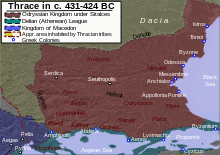Lysimachia (Thrace)

Lysimachia (Template:Lang-el) was an important Hellenistic Greek town on the north-western extremity of the Thracian Chersonese (the modern Gallipoli peninsula) in the neck where the peninsula joins the mainland in what is now the European part of Turkey, not far from the bay of Melas (the modern Gulf of Saros).
History
The city was built by Lysimachus in 309 BCE, when he was preparing for the last struggle with his rivals; for the new city, being situated on the isthmus, commanded the road from Sestos to the north and the mainland of Thrace. In order to obtain inhabitants for his new city, Lysimachus destroyed the neighbouring town of Cardia, the birthplace of the historian Hieronymus,[1] and settled the inhabitants of it and other Chersonesean cities here.[2] Lysimachus no doubt made Lysimachia the capital of his kingdom, and it must have rapidly risen to great splendour and prosperity.
After his death the city fell under the dominion of Syria, and during the wars between Seleucus Callinicus and Ptolemy Euergetes it passed from the hands of the Seleucids into those of the Ptolemies. Whether these latter set the town free, or whether it emancipated itself, is uncertain; at any rate it entered into the relation of sympolity with the Aetolian League. In 287 BC, the city was severely damaged by an earthquake, as reported by the Roman historian Justin (17.1.1-3). In 277 BCE near Lysimachia the Macedonian king Antigonus II Gonatas defeated the Gauls. As the Aetolians were not able to afford the town the necessary protection, it was destroyed again in 197 BCE by the Thracians during the war of the Romans against Philip of Macedonia. Antiochus the Great restored the place, collected the scattered and enslaved inhabitants, and attracted colonists from all parts by generous promises.[3] This restoration, however, appears to have been unsuccessful, and under the dominion of Rome it decayed more and more.
The last time the place is mentioned under its ancient name, is in a passage of Ammianus Marcellinus.[4] The emperor Justinian (527–565) restored it and surrounded it with strong fortifications,[5] and after that time it is spoken of only under the name of Hexamilion.[6] The place now occupying the site of Lysimachia, Eksemil, derives its name from the Justinianian fortress, though the ruins of the ancient city are more numerous in the neighbouring village of Ortaköy.
References
- William Smith (editor). "Lysimachia", Dictionary of Greek and Roman Geography, London (1854).
Justin 17.1.1-3
Notes
- ^ Strabo, Geography, ii. 5, vii. 52, 54; Pausanias, Description of Greece, i. 9; Diodorus Siculus, Bibliotheca, xx. 29; Polybius, Histories, v. 34; Pliny, Natural History, iv. 18.
- ^ John Freely (1998). Turkey around the Marmara. SEV Matbaalıcık ve Yayıncılık, A.Ş. İstanbul. p.104.
- ^ Livy, History of Rome, xxxiii. 38, 40; Appian, The Foreign Wars, "The Syrian Wars", 1.
- ^ Ammianus Marcellinus, Histoire de Rome, xxii. 8.
- ^ Procopius, De aedificiis, iv. 10.
- ^ Symeon Metaphrastes, Chronicon.
![]() This article incorporates text from a publication now in the public domain: Smith, William, ed. (1854–1857). Dictionary of Greek and Roman Geography. London: John Murray.
This article incorporates text from a publication now in the public domain: Smith, William, ed. (1854–1857). Dictionary of Greek and Roman Geography. London: John Murray. {{cite encyclopedia}}: Missing or empty |title= (help)
- 309 BC establishments
- Populated places established in the 4th century BC
- Ancient Greek cities
- Archaeological sites in the Marmara Region
- Ancient Greek sites in Turkey
- Lysimachian colonies
- Geography of ancient Thrace
- Former populated places in Turkey
- Hellenistic colonies in Thrace
- Geography of Çanakkale Province
- History of Çanakkale Province
- Visitor attractions in Çanakkale Province
